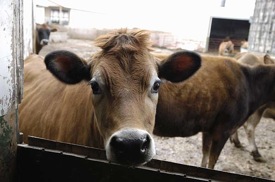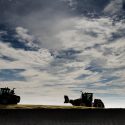Wisconsin farm income set a record last year, but high grain prices cut into dairy profits
Agriculture continued to be a bright spot in Wisconsin’s economy in 2011.
Wisconsin net farm income set a new record, fueled by record prices for corn, soybeans, milk, cattle and hogs, according to University of Wisconsin–Madison agricultural economists in their 2012 Status of Wisconsin Agriculture report.

The Status of Wisconsin Agriculture Report estimates that total Wisconsin net farm income rose 17 percent last year.
Photo: Jeff Miller
The report’s authors estimate that the state’s farmers collectively earned a record $2.4 billion in net farm income, up about 17 percent from 2010 and three times what they earned in 2009, when plunging milk prices put many dairy operations in the red.
But not all of the state’s commodity sectors benefited equally, the report notes. While soaring corn and soybean prices boosted profits for crop producers, they trimmed those of farmers who have to buy grain or grain-based products to feed livestock.
“For dairy farmers who purchased all of their feed in 2011, milk income over feed costs was about the same as 2010, even though milk prices were about $4 per hundredweight (about 25 percent) higher,” according to the report, which was released Wednesday, Jan. 25 in conjunction with the 2012 Wisconsin Agricultural Economic Outlook Forum on the UW–Madison campus.
The UW ag economists warn that dairy farmers’ profit margins will probably shrink in 2012, because grain prices are expected to remain high while milk prices could drop as much as 6-10 percent. But they caution that what really happen will depend on a broad range of uncertain factors, ranging from the impact of the drought in Texas and nearby states on feed prices and dairy cow numbers, to how a weaker euro and stronger dollar will crimp U.S. dairy exports.
Wisconsin farmers began 2011 in much better financial shape than in the previous year, the report notes. The combined net worth of the state’s farmers increased by $1.2 billion, or 3 percent, during 2010, which more than erased the $700 million drop in equity they’d experienced in 2009. As in the past, the boost in farm equity was due mostly to higher land values.
Other observations in the report:
- Land costs are climbing. The state’s farmland prices were 17 percent higher at the end of the third quarter of 2011 than they’d been a year earlier. Cash rents have risen about 38 percent from 2007 to 2011.
- Farm debt grew a bit but remains relatively low. In 2010 Wisconsin farmers owed 11 cents for every dollar’s worth of assets that they owned. The average debt-to-asset ratio was about twice that during the farm financial crisis of the 1980s.
¬- Wisconsin farmers’ working capital-the value of their inventory of crops, non-breeding livestock, supplies and other current assets, minus short-term debt and accounts payable-grew about 10 percent to $4.65 billion, signaling that they were generally profitable and had good cash flow.
- State corn producers harvested a record 518 million bushels in 2011, beating out the previous record set in 2010 by 16 million bushels. With record corn production and record high corn prices in 2010 and 2011, corn growers have had two outstanding years.
- Wisconsin’s milk production was nearly flat in 2011, up a scant 0.2 percent after climbing 18 percent over the past five years. This is well behind a nationwide increase of 1.7 percent. The state’s poor showing reflects a negligible increase in milk cow numbers and poor production per cow-particularly during unusually hot summer months. High grain prices will likely discourage producers from adding cows or boosting rations in the months to come, dampening the rise in total milk production.
- Potato and vegetable growers suffered through a long, cold, wet spring, which delayed planting. Potato yields were down 8-9 percent. Processing vegetable acreage was down, partly because high grain prices made farmers less inclined to sign contracts with processors.


